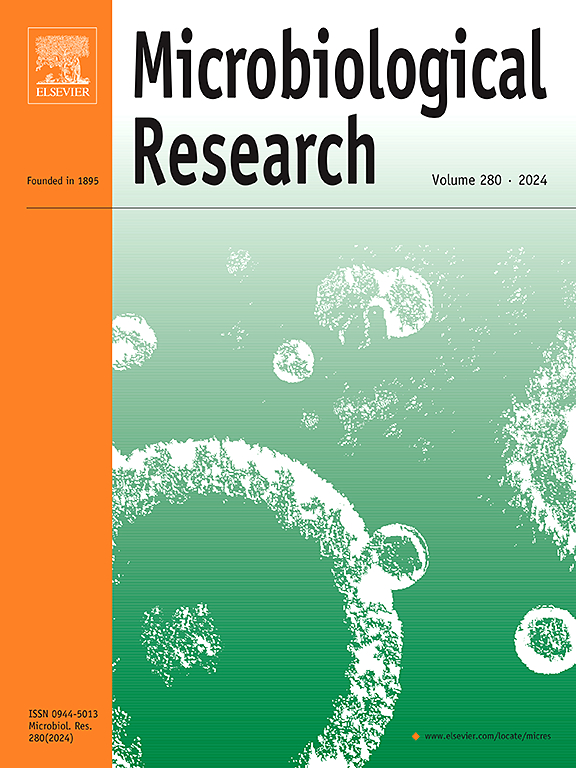Rhizosphere bacterial communities of Namib Desert plant species: Evidence of specialised plant-microbe associations
IF 6.1
1区 生物学
Q1 MICROBIOLOGY
引用次数: 0
Abstract
Rhizosphere microbial communities are intimately associated with plant root surfaces. The rhizosphere microbiome is recruited from the surrounding soil and is known to impact positively on the plant host via enhanced resistance to pathogens, increased nutrient availability, growth stimulation and increased resistance to desiccation. Desert ecosystems harbour a diversity of perennial and annual plant species, generally exhibiting considerable physiological adaptation to the low-water environment. In this study, we explored the rhizosphere bacterial microbiomes associated with selected desert plant species. The rhizosphere bacterial communities of 11 plant species from the central Namib Desert were assessed using 16S rRNA gene-dependent phylogenetic analyses. The rhizosphere microbial community of each host plant species was compared with control soils collected from their immediate vicinity, and with those of all other host plants. Rhizosphere and control soil bacterial communities differed significantly and were influenced by both location and plant species. Rhizosphere-associated genera included 67 known plant growth-promoting taxa, including Rhizobium, Bacillus, Microvirga, Kocuria and Paenibacillus. Other than Kocuria, these genera constituted the ‘core’ rhizosphere bacterial microbiome, defined as being present in > 90 % of the rhizosphere communities. Nine of the 11 desert plant species harboured varying numbers and proportions of species-specific microbial taxa. Predictive analyses of functional pathways linked to rhizosphere microbial taxa showed that these were significantly enriched in the biosynthesis or degradation of a variety of substances such as sugars, secondary metabolites, phenolic compounds and antimicrobials. Overall, our data suggest that plant species in the Namib Desert recruit unique taxa to their rhizosphere bacterial microbiomes that may contribute to their resilience in this extreme environment.
纳米布沙漠植物的根际细菌群落:专门的植物-微生物关联的证据。
根际微生物群落与植物根表面密切相关。根际微生物群是从周围土壤中吸收的,已知通过增强对病原体的抵抗力、增加养分利用率、刺激生长和增强对干燥的抵抗力,对植物宿主产生积极影响。沙漠生态系统拥有多种多年生和一年生植物物种,通常对低水环境表现出相当大的生理适应性。在这项研究中,我们探索了与选定的沙漠植物物种相关的根际细菌微生物群。采用16S rRNA基因依赖性系统发育分析方法对纳米布沙漠中部11种植物根际细菌群落进行了分析。将每一种寄主植物的根际微生物群落与从其邻近地区收集的对照土壤以及所有其他寄主植物的根际微生物群落进行比较。根际和对照土壤细菌群落差异显著,并受地点和植物种类的影响。根际相关属包括根瘤菌、芽孢杆菌、微virga、Kocuria和Paenibacillus等67个已知植物生长促进类群。除了Kocuria外,这些属构成了“核心”根际细菌微生物组,定义为存在于> 90 %的根际群落中。11种沙漠植物中有9种具有不同数量和比例的物种特异性微生物分类群。与根际微生物分类群相关的功能途径的预测分析表明,这些功能途径在糖、次生代谢物、酚类化合物和抗菌剂等多种物质的生物合成或降解中显著富集。总的来说,我们的数据表明,纳米布沙漠的植物物种在其根际细菌微生物群中招募了独特的分类群,这可能有助于它们在这种极端环境中的恢复力。
本文章由计算机程序翻译,如有差异,请以英文原文为准。
求助全文
约1分钟内获得全文
求助全文
来源期刊

Microbiological research
生物-微生物学
CiteScore
10.90
自引率
6.00%
发文量
249
审稿时长
29 days
期刊介绍:
Microbiological Research is devoted to publishing reports on prokaryotic and eukaryotic microorganisms such as yeasts, fungi, bacteria, archaea, and protozoa. Research on interactions between pathogenic microorganisms and their environment or hosts are also covered.
 求助内容:
求助内容: 应助结果提醒方式:
应助结果提醒方式:


